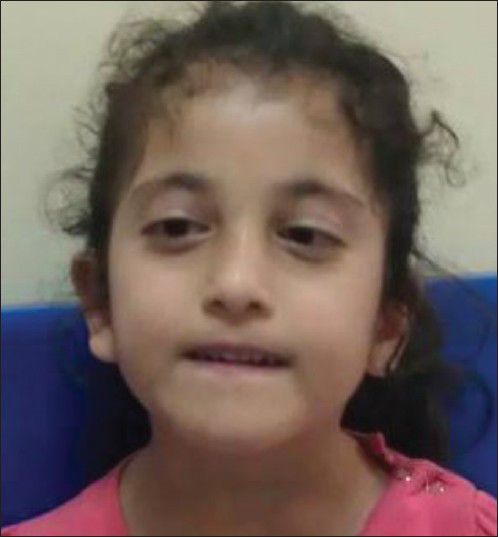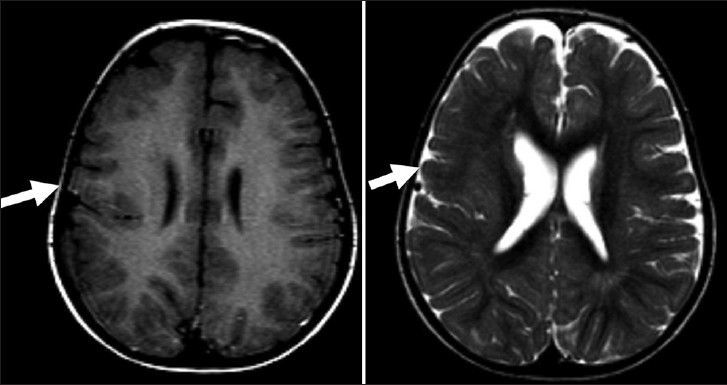Kabuki syndrome (KS) comprises a unique facial pattern with large palpebral fissures, malar flattening and everted lower eyelids, postnatal growth deficiency, skeletal anomalies, dermatoglyphic abnormalities, and mental retardation. Visceral anomalies such as congenital heart defects and urinary tract anomalies have also been reported.[1] KS was described independently by Niikawa et al.[2] and Kuroki et al.[3] A majority of cases have been reported from Japan,[4] but patients are found in other ethnic groups as well.[5,6] Neurologic anomalies are frequently reported for KS, although cortical dysplasia is uncommon. Here, we report a 5-year, 7-month-old female patient with KS who had perisylvian cortical dysplasia. To our knowledge, this is the first Turkish case of KS to present with unilateral perisylvian cortical dysplasia.
Our patient a 5-year, 7-month-old girl, was referred for neurologic evaluation because of developmental delay and atypical facial pattern. She was a 3,580 g (75th-90th centile), 48 cm-long (25th-50th centile) product of a 39-week gestation to a 26-year-old G2 P2 woman delivered through C-section after a prolonged labor and fetal distress. At newborn period, heart murmur was diagnosed and ventricular septal defect and patent ductus arteriosus were determined by echocardiography. Medical history revealed that head holding occurred at 12 months, sitting without support occurred at 17 months, and walking started at 3 years of age; no consanguinity was found between the patient's mother and father. No feeding difficulties were documented. There was no family history of febrile seizure or epilepsy, genetic syndrome, or neurological disease. Her facial anomalies included long and wide palpebral fissures with ectropion of the lateral third of the lower eyelids, ptosis, convergent strabismus, prominent earlobes [Figure 1], and high-arched palate. She also had other dysmorphic features including bilateral fifth finger clinodactyly, the proximal- located first fingers in hands, and over-riding in the second and third digits of bilateral foot. Her psychomotor development was delayed. She could assemble simple two-word sentences. These findings were consistent with KS. Laboratory tests including the determination of lactic acid, pyruvic acid, creatine phosphokinase, and amino acids in the blood yielded normal results. Pelvis graphy showed coxa vara deformity of the hip (on the left). Results of chromosome analysis were normal (46, XX), and no alterations in chromosome 22 were detected by fluorescence in situ hybridization (FISH). Abdominopelvic ultrasonography was normal. Brain magnetic resonance imaging (MRI) revealed cortical dysplasia along the right sylvian fissure [Figure 2]. Electroencephalogram (EEG) showed no epileptiform activity.
Figure 1.

Picture of the facial characteristics in the Kabuki syndrome patient
Figure 2.

Brain magnetic resonance imaging revealed cortical dysplasia along the right Sylvian fissure
Intellectual disability is the cardinal manifestation of KS syndrome. Although mild to moderate mental retardation was observed in over 90% of reported cases, a wide spectrum of structural central nervous system anomalies has been reported as well.[7] Brain malformations previously described in children with KS include microcephaly, cerebellar atrophy, hydrocephalus, Dandy-Walker malformation, Arnold-Chiari malformation, syringohydromyelia, dysgenesis/agenesis of the corpus callosum, hippocampal atrophy, polymicrogyria, subarachnoid cysts, and periventricular heterotopias.[7,8] Perisylvian cortical dysplasia was reported to be rare in patients with KS.[8] In literature, KS with cortical dysplasia has been previously reported in six cases. Yoshioka et al. reported a two-year-old Japanese male patient with left perisylvian cortical dysplasia. They noted that he did not develop seizures, except for one simple febrile seizure, and did not have dysarthria. Furthermore, epileptiform activity could not be determined at his electroencephalography.[8] Similarly, our patient had unilateral perisylvian cortical dysplasia and her seizures were absent. Moroever, her electroencephalography findings were normal. Takano et al. showed bilateral perisylvian pachygyric cortex in a male Japanese infant with KS with a failure to thrive and achieve neck control.[9] In the autopsy of a Caucasian boy with KS, focal polymicrogyria was described in the inferior frontal and lateral temporal lobes by Wilson et al.[10] Di Gennaro et al. reported an Italian female adolescent with KS presenting with epilepsy and having MRI evidence of occipital polymicrogyria.[11] In another report, Powell et al. reported a 22 year old patient who had bilateral perisylvian polymicrogyria and presented with refractory partial epilepsy.[12] They reported that this patient presented with dysarthria and mental retardation, with seizures starting at 12 years of age. Mihci et al. reported a 7-year-old Turkish boy with periventricular nodular heterotopia and epilepsy.[13] To the best of our knowledge, there are no reports of perisylvian cortical dysplasia in Turkish patients with KS. Including this patient, only two KS with cortical dysplasia have been reported from Turkey. Although central nervous system anomalies are reported to be often associated with KS in non-Japanese patients, it is worth noting that half of the cases with cortical dysplasia are reported to be Caucasian.
Case reports indicate that the presence of cortical dysplasia may not always result in the development of epilepsy or seizures. The presence of perisylvian cortical dysplasia indicates that careful observation will be required in cases with KS because of the development of neurological symptoms, especially seizure and dysarthria. Brain imaging of KS patients is essential for the confirmation of central nervous system abnormalities.
References
- 1.Adam MP, Hudgins L. Kabuki syndrome: A review. Clin Genet. 2005;67:209–19. doi: 10.1111/j.1399-0004.2004.00348.x. [DOI] [PubMed] [Google Scholar]
- 2.Niikawa N, Matsuura N, Fukushima Y, Ohsawa T, Kajii T. Kabuki make-up syndrome: A syndrome of mental retardation, unusual facies, large and protruding ears, and postnatal growth deficiency. J Pediatr. 1981;99:565–9. doi: 10.1016/s0022-3476(81)80255-7. [DOI] [PubMed] [Google Scholar]
- 3.Kuroki Y, Suzuki Y, Chyo H, Hata A, Matsui I. A new malformation syndrome of long palpebral fissures, large ears, depressed nasal tip, and skeletal anomalies associated with postnatal dwarfism and mental retardation. J Pediatr. 1981;99:570–3. doi: 10.1016/s0022-3476(81)80256-9. [DOI] [PubMed] [Google Scholar]
- 4.Handa Y, Maeda K, Toida M, Kitajima T, Ishimaru J, Nagai A, et al. Kabuki make-up syndrome (Niikawa-Kuroki syndrome) with cleft lip and palate. J Craniomaxillofac Surg. 1991;19:99–101. doi: 10.1016/s1010-5182(05)80570-0. [DOI] [PubMed] [Google Scholar]
- 5.Burke LW, Jones MC. Kabuki syndrome: Underdiagnosed recognizable pattern in cleft palate patients. Cleft PalateCraniofac J. 1995;32:77–84. doi: 10.1597/1545-1569_1995_032_0077_ksurpi_2.3.co_2. [DOI] [PubMed] [Google Scholar]
- 6.Carcione A, Piro E, Albano S, Corsello G, Benenati A, Piccione M, et al. Kabuki make-up (Niikawa-Kuroki) syndrome: Clinical and radiological observations in two Sicilian children. Pediatr Radiol. 1991;21:428–31. doi: 10.1007/BF02026678. [DOI] [PubMed] [Google Scholar]
- 7.Ben-Omran T, Teebi AS. Structural central nervous system (CNS) anomalies in Kabuki syndrome. Am J Med Genet A. 2005;137:100–3. doi: 10.1002/ajmg.a.30842. [DOI] [PubMed] [Google Scholar]
- 8.Yoshioka S, Takano T, Matsuwake K, Sokoda T, Takeuchi Y. A Japanese patient with Kabuki syndrome and unilateral perisylvian cortical dysplasia. Brain Dev. 2011;33:174–6. doi: 10.1016/j.braindev.2010.04.001. [DOI] [PubMed] [Google Scholar]
- 9.Takano T, Matsuwake K, Yoshioka S, Takeuchi Y. Congenital polymicrogyria including the perisylvian region in early childhood. Congenit Anom (Kyoto) 2010;50:64–7. doi: 10.1111/j.1741-4520.2009.00253.x. [DOI] [PubMed] [Google Scholar]
- 10.Wilson GN. Thirteen cases of Niikawa-Kuroki syndrome: Report and review with emphasis on medical complications and preventive management. Am J Med Genet. 1998;79:112–20. doi: 10.1002/(sici)1096-8628(19980901)79:2<112::aid-ajmg7>3.0.co;2-s. [DOI] [PubMed] [Google Scholar]
- 11.Di Gennaro G, Condoluci C, Casali C, Ciccarelli O, Albertini G. Epilepsy and polymicrogyria in Kabuki make-up (Niikawa-Kuroki) syndrome. Pediatr Neurol. 1999;21:566–8. doi: 10.1016/s0887-8994(99)00030-2. [DOI] [PubMed] [Google Scholar]
- 12.Powell HW, Hart PE, Sisodiya SM. Epilepsy and perisylvian polymicrogyria in a patient with Kabuki syndrome. Dev Med Child Neurol. 2003;45:841–3. doi: 10.1017/s0012162203001567. [DOI] [PubMed] [Google Scholar]
- 13.Mihçi E, Taçoy S, Haspolat S, Karaali K. Central nervous system abnormalities in Kabuki (Niikawa-Kuroki) syndrome. Am J Med Genet. 2002;111:448–9. doi: 10.1002/ajmg.10573. [DOI] [PubMed] [Google Scholar]


